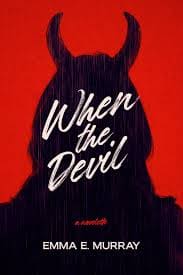
Synopsis
In When the Devil, Libby finds salvation in a new sapphic partner, homebrewed poison, and facing a God she no longer believes in.
Review
When I finished Emma E. Murray’s novelette, When the Devil, my first thought was that it was a kind of demonic version of the classic novel, Fried Green Tomatoes, and the more I’ve thought about it, the more I think the comparison holds.
Both novels give us a lesbian romance in the heart of a stifling, rural community. Both feature a pair of polar opposite female leads who somehow click despite their differences. Both deal with the question of women’s roles. Both involve women banding together in the face of dangerous, abusive men. Both even involve the murder of such men.
But only When the Devil has June, a murderous version of Idgie Threadgood, who doesn’t just bristle against social convention, she destroys them, one tyrannical man at a time.
Libby is a mousy housewife, all but held prisoner in her house by her creepy truck driver husband and her domineering grandfather. As the story opens, her grandmother has just died, leaving Libby stranded alone in this world of men.
When June arrives next door, she initially presents as the Manic Pixie Dream Girl, here to shake Libby out of her complacency, awaken her sapphic desires, and teach her how to live. And there is certainly some of that at work here, but June has a dark side as well. June’s philosophy is that there are only two forces at work in the world: violence and pleasure. And she takes this pragmatic if troubling philosophy to heart.
Soon, the bodies begin to pile up, and Libby, horrified as she is, can’t quite break free from June’s dark orbit. More importantly, she isn’t sure she wants to.
Novelettes are a difficult form to really get just right. How to make it feel like something complete rather than simply a long short story? When the Devil hits that target, and it dies so with prose that is assured and beautiful and full of regional flavor without ever sounding stagy or false.
Over the course of a story that is easily read in a single sitting, When the Devil raises many questions about morality, passion, religion, and self-determination, and it ends with just enough ambiguity so as not to pretend that it has any real answers to these questions.
The book drops the reader into a well-drawn world peopled with cleanly drawn characters, and it has the courage to let them do their thing. The results, if not exactly uplifting, are powerful.








Leave a Reply